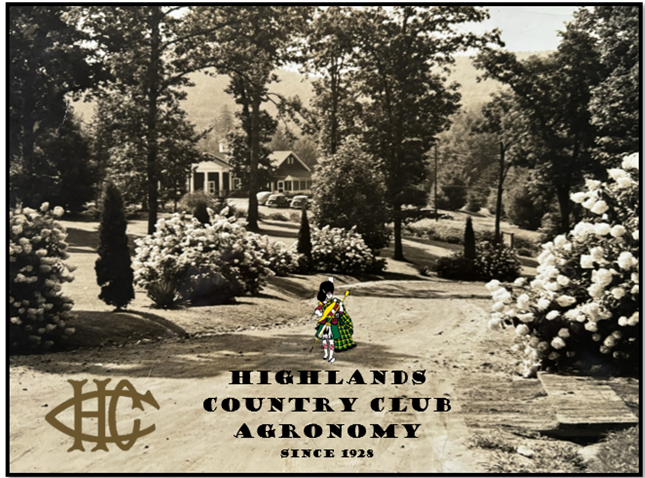Why do we topdress greens with sand?
This past week, I understand there was some discussion surrounding our decision to topdress greens frequently. First, let me start by saying that the light sand topdressing we did to greens on July 3rd, should have been better timed and I certainly apologize to those who feel it negatively affected their experience on the golf course. With high humidity and morning moisture, the sand can stick to the golf ball and impact the roll. In the afternoon however, no putting green putts better than one that's been freshly topdressed. The sand smooths the imperfections on the surface and lowers the height of cut of the turf, from the ground up. The end result are greens that gain over a foot on the stimpmeter and roll smoother than any amount of rolling could provide.
But the main reason we topdress is to match the accumulation of organic matter (thatch) below the surface. Greens that aren't regularly topdressed become slow and soft. They will begin to hold more and more water until eventually, the green fails. Simply put, sand topdressing is probably the most critical maintenance practice we do.
How often do we topdress and why does it feel we are doing it more this year?
Historically for the last 20 years, we would topdress once every 14 days. Traditionally, this has be enough to match the accumulation of organic matter (thatch) below the greens, at Highlands CC. As you know, we rebuilt #12 and #14 greens this year. These greens were sodded in March, and while I was extremely pleased with the quality of the sod, it did have more organic matter than I would have liked. This is why those two greens were constantly being aerified in the spring- it was an aggressive program to remove as much organic matter we could. Since we don't want to aerate during the season and impact the greens more than we have to, we increased our topdressing frequency to as much as once or even twice a week at times. Rather than just topdressing #12 and #14, I elected to include all the greens on the golf course so they could receive the same benefit. In addition, when we topdress, we also include the approaches along with the greens, and that has been paying off over the years by helping to firm these areas. It's critical we deal organic matter (thatch) while it is near the surface and at a depth that we can reach through traditional aeration and sand topdressing!
Let me also stress that in a perfect situation, sand topdressing is applied in the afternoon, when the greens are dry, allowing the sand to fall down into the canopy. When we topdress in the morning and there is moisture on the leaf blade, the sand tends to stick to leaf, which causes the issues mentioned above. We do our best to avoid morning topdressings. This year, however, has been a challenge. We are experiencing a year with record play. Many days, the golf course is so full, it's nearly impossible to get afternoon tasks completed in a timely manner, without working consistent overtime. Our golf course maintenance budget has no wiggle room in it and can't we can't afford paying regular overtime to our team. Therefore, some of the afternoon tasks we used to do, are now pushed to the morning. Lately, topdressing has been one of those, unfortunately.
What's the overall benefit?
Again, putting greens that are regularly topdressed will play faster, smoother and firmer than those that are not on a frequent sand topdressing program. This year, I've received m0re positive comments from members about how pleased they are with the putting greens. Many comment how they love the faster green speeds. Historically, our green speed would be right around 11ft and this year, it's consistently 12' plus on a daily basis. There is no question the greens are performing better this year than ever before. This is a result of one thing... more frequent topdressing! The benefits of a single topdressing application last about 3 days. In the past, when we topdressed greens every 14 days, it was done on a Monday. This means that those golfers who only play on weekends, never got to experience the benefit of recently topdressed greens. Therefore, I experimented with the timing of our sand applications in order to provide the most benefit to the whole. Going forward, I'll continue to work with the Green Committee to develop the best topdressing program for Highlands CC. Once again, my intent by applying sand on July 3rd was to give members and guests the best greens possible over the holiday weekend. Over the next 2 months, the topdressing of greens will slow back down. Sand can be very abrasive to the turf, and it's best to space out applications during the heat of the summer, when the greens are most stressed. Once fall rolls around, we'll more than likely increase the frequency of sand applications as needed.
Conclusion
You are why we are here! Your opinion of the golf course means everything to me and my team, and we love hearing from you- good or bad. In fact, if we don't hear the bad, we can't get better! Please never hesitate to reach out to me if you have questions about anything we're doing on the golf course or have a suggestion to improve the experience on the golf course for members and their guests. We are a team of 23, all with a can-do attitude and we'll do what it takes to make Highlands CC the best for its members.

